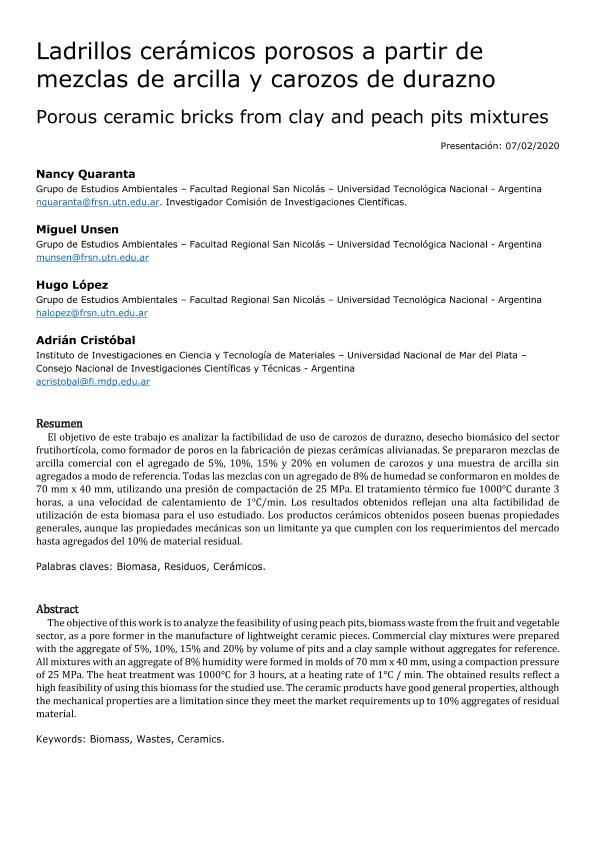Mostrar el registro sencillo del ítem
dc.contributor.author
Quaranta, Nancy Esther

dc.contributor.author
Unsen, Miguel Angel

dc.contributor.author
López, Hugo
dc.contributor.author
Cristobal, Adrian Alberto

dc.date.available
2021-09-28T11:11:54Z
dc.date.issued
2020-03
dc.identifier.citation
Quaranta, Nancy Esther; Unsen, Miguel Angel; López, Hugo; Cristobal, Adrian Alberto; Ladrillos cerámicos porosos a partir de mezclas de arcilla y carozos de durazno; Universidad Tecnológica Nacional; Revista Tecnología y Ciencia; 38; 3-2020; 37-49
dc.identifier.issn
1666-6933
dc.identifier.uri
http://hdl.handle.net/11336/141666
dc.description.abstract
El objetivo de este trabajo es analizar la factibilidad de uso de carozos de durazno, desecho biomásico del sectorfrutihortícola, como formador de poros en la fabricación de piezas cerámicas alivianadas. Se prepararon mezclas dearcilla comercial con el agregado de 5%, 10%, 15% y 20% en volumen de carozos y una muestra de arcilla sinagregados a modo de referencia. Todas las mezclas con un agregado de 8% de humedad se conformaron en moldes de70 mm x 40 mm, utilizando una presión de compactación de 25 MPa. El tratamiento térmico fue 1000°C durante 3horas, a una velocidad de calentamiento de 1°C/min. Los resultados obtenidos reflejan una alta factibilidad deutilización de esta biomasa para el uso estudiado. Los productos cerámicos obtenidos poseen buenas propiedadesgenerales, aunque las propiedades mecánicas son un limitante ya que cumplen con los requerimientos del mercadohasta agregados del 10% de material residual.
dc.description.abstract
The objective of this work is to analyze the feasibility of using peach pits, biomass waste from the fruit and vegetable sector, as a pore former in the manufacture of lightweight ceramic pieces. Commercial clay mixtures were prepared with the aggregate of 5%, 10%, 15% and 20% by volume of pits and a clay sample without aggregates for reference. All mixtures with an aggregate of 8% humidity were formed in molds of 70 mm x 40 mm, using a compaction pressure of 25 MPa. The heat treatment was 1000°C for 3 hours, at a heating rate of 1°C / min. The obtained results reflect a high feasibility of using this biomass for the studied use. The ceramic products have good general properties, although the mechanical properties are a limitation since they meet the market requirements up to 10% aggregates of residual material.
dc.format
application/pdf
dc.language.iso
spa
dc.publisher
Universidad Tecnológica Nacional
dc.rights
info:eu-repo/semantics/openAccess
dc.rights.uri
https://creativecommons.org/licenses/by-nc/2.5/ar/
dc.subject
Biomasa
dc.subject
Residuos
dc.subject
Cerámicos
dc.subject.classification
Cerámicos

dc.subject.classification
Ingeniería de los Materiales

dc.subject.classification
INGENIERÍAS Y TECNOLOGÍAS

dc.title
Ladrillos cerámicos porosos a partir de mezclas de arcilla y carozos de durazno
dc.title
Porous ceramic bricks from clay and peach pits mixtures
dc.type
info:eu-repo/semantics/article
dc.type
info:ar-repo/semantics/artículo
dc.type
info:eu-repo/semantics/publishedVersion
dc.date.updated
2021-08-19T20:34:31Z
dc.journal.number
38
dc.journal.pagination
37-49
dc.journal.pais
Argentina

dc.journal.ciudad
Buenos Aires
dc.description.fil
Fil: Quaranta, Nancy Esther. Universidad Tecnológica Nacional. Facultad Regional San Nicolás; Argentina
dc.description.fil
Fil: Unsen, Miguel Angel. Universidad Tecnológica Nacional. Facultad Regional San Nicolás; Argentina
dc.description.fil
Fil: López, Hugo. Universidad Tecnológica Nacional. Facultad Regional San Nicolás; Argentina
dc.description.fil
Fil: Cristobal, Adrian Alberto. Consejo Nacional de Investigaciones Científicas y Técnicas. Centro Científico Tecnológico Conicet - Mar del Plata. Instituto de Investigaciones en Ciencia y Tecnología de Materiales. Universidad Nacional de Mar del Plata. Facultad de Ingeniería. Instituto de Investigaciones en Ciencia y Tecnología de Materiales; Argentina
dc.journal.title
Revista Tecnología y Ciencia
dc.relation.alternativeid
info:eu-repo/semantics/altIdentifier/url/https://rtyc.utn.edu.ar/index.php/rtyc/article/view/596
dc.relation.alternativeid
info:eu-repo/semantics/altIdentifier/doi/http://dx.doi.org/10.33414/rtyc.38.37-49.2020
Archivos asociados
